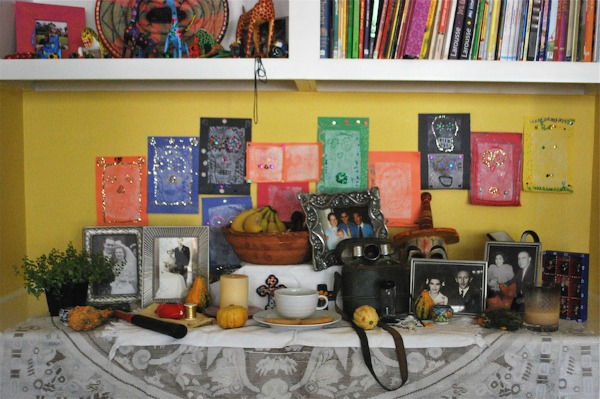Every year when we open up our box of Halloween pumpkins, ghosts, spiders and bats, we also take out the Día de los Muertos skulls and skeletons we pack in the same box. The day before trick-or-treating, we set up our ofrenda: a memorial or altar that pays tribute to family members and friends who have died. The ofrenda is a collection of treasures, pictures, food, special items and candles to remind the families of their loved ones.
Learning about celebrations around the world not only heightens cultural understanding, it helps children learn our similarities and differences, what other cultures value, and for our own kids, it instills pride in their own heritage. Understanding the reasons behind different celebrations helps to promote cultural awareness and eliminates negative attitudes or prejudices. In Day of the Dead, we see the values of family, our ancestors, of certain traditions and rituals, and of the belief in life after death.
Día de los Muertos, or Todos Santos is a holiday that stems from the Catholic All Saints’ Day/All Souls’ Day, combined with Aztec rituals celebrating the lives of our ancestors. In fact, it is celebrated in Mexico, Guatemala, Bolivia, Ecuador, and other Latin American countries. Because my husband is from Mexico City, we try to keep Mexican traditions alive and teach our kids about this special celebration.
After gathering the materials for our altar we set out some favorites foods and some water, because traditionally people have believed that the spirits are hungry and thirsty from their journey. The kids gathered the skeletons (calacas) and skulls (calaveras), and hung up their skull art project since we didn’t have any papel picado available. Traditional ofrendas also typically have cempasuchitl (marigolds), candles and incense to lead the spirits to the altar for their visit.
But everyone’s favorite part is when we gather items to represent our grandparents’ favorite activities, hobbies and even vices. My maternal grandfather was a gardener, who loved to fish, and could build and fix anything. We represented his interests with a plant, a hammer, and a fishing lure, near his photograph. For Toño’s grandfather, we had a flask of tequila, an old level and a bunch of bananas. As I explained each object to my kids, the stories began to flow. His maternal grandfather surveyed land all over Mexico and was sometimes paid in unique commodities. One time he brought home a whole banana stem from the Yucatan peninsula. After carrying it home all the way back to Mexico City, he laid it on the floor, a huge, hairy tarantula crawled out, and everyone screamed!
For our family, and families across Latin America, Día de los Muertos is not only about keeping a tradition alive and instilling pride- though these certainly play a part. This special holiday is a chance for our children to learn about relatives that they might not remember or maybe haven’t ever met. As families sit together and share special stories about our loved ones, we get to strengthen our memories and show our children what beautiful families they are a part of.



Your altar is so beautiful with all those pictures. It´s vibrant. Thanks for sharing it with us!
Thank you! It was sad, but healing at the same time to remember our dear grandparents.
Becky, I love that every object that represents your loved ones bring up a story for you to share with your children. I didn’t do an altar this year, but I will next one and now I know I’ll be doing the same with the objects I use to represent my Dad. My son will be at a good age to understand some of the stories I already know I’ll be telling him and his older sister. Gracias!
I was so touched this year when my daughter remembered that we used a hammer for my grandpa last year because as she said “he could fix anything!” We’re keeping their memories alive and showing our kids what a loving family they come from.
What a wonderful tradition! I love the skull crafts that they hung up on the wall behind the ofrenda. I’m sure your children will appreciate all the stories that you’ve shared with them as they celebrate each year. This is similar to a tradition that they have in Korea during Chuseok….a family altar celebrating ancestors and a visit to the cemetary to clean off the graves and leave food.
I was wondering if other cultures had similar holidays. I know in China they have a holiday to clean off the graves, with veneration of the loved ones who have passed away. It’s such a nice holiday, to remember our family members and friends and keep the memories alive for the next generation.